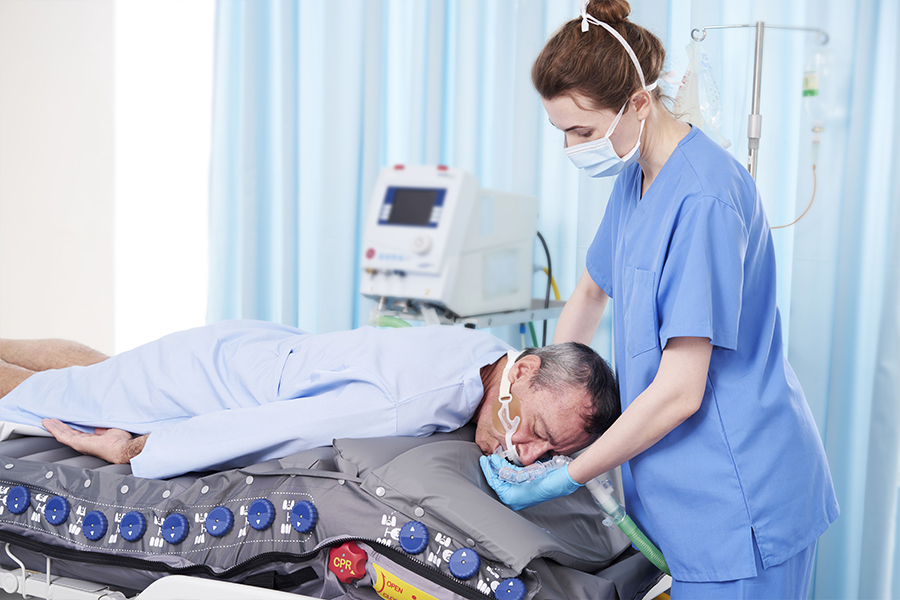Pressure injury prevention in prone position, for influenza patients with ARDS
About Flu (Influenza)
Influenza (flu) is a contagious respiratory illness caused by influenza viruses that infect the nose, throat, and lungs. Flu season usually occurs in the fall and winter. While influenza viruses spread year-round, most of the time flu activity peaks between December and February.1
Most people with the flu get better on their own. But sometimes, influenza and its complications can be deadly. People at higher risk of developing flu complications include young children under age 2, adults older than age 65, residents of nursing homes and other long-term care facilities, people who are pregnant or plan to be pregnant during flu season, people with weakened immune systems and people who have chronic illnesses, such as asthma, heart disease, kidney disease, liver disease and diabetes.1,2
Common symptoms of the flu include fever, aching muscles, chills and sweats, headache, cough, shortness of breath, tiredness and weakness, runny or stuffy nose and sore throat.2,3
Acute respiratory distress syndrome (ARDS) reduces blood oxygen to dangerously low levels
ARDS is a fatal complication of influenza infection. ARDS involves damage to the epithelial–endothelial barrier, fluid leakage into the alveolar lumen, and respiratory insufficiency.4 ARDS occurs rapidly and leads to respiratory failure. All patients with ARDS will require extra oxygen even with ventilator support. A ventilator is a machine used to open airspaces that have shut down and help with the work of breathing. The ventilator is connected to the patient through a mask on the face or a tube inserted into the trachea. When oxygen and ventilator therapies are at high levels and blood oxygen is still low, ARDS patients are sometimes turned over on their stomach to get more oxygen into the blood. This is called proning.5

Figure : An ARDS patient in prone position.
Prone positioning is a complicated task
Prone positioning during mechanical ventilation is strongly recommended in adults with ARDS, but entails an increased risk of complications; specifically, pressure injury. Thus, ensuring the patient is correctly positioned and protected from injury is a crucial activity. Patients remain in the prone position for at least 12 hours with the head repositioned every 2–4 hours. Moving patients into and out of a prone position is labor-intensive, requiring numerous highly trained staff members.6
Pressure redistribution surfaces for pressure injury prevention
Acquiring pressure redistribution surfaces, with automating prone shoulder lifting and full-body pressure relief, can reduce workflow complexity in head repositioning, and pressure injury risks, boosting long-term cost-effectiveness and patient care.7
References
1. Flu Season (September 20, 2022). CDC. Retrieved November 25, 2022.
2. Influenza (Flu) (October 15, 2022). Mayo Clinic. Retrieved November 25, 2022.
3. Flu Symptoms & complications (October 3, 2022). CDC. Retrieved November 25, 2022.
4. Kirsty R Short, Edwin J B Veldhuis Kroeze, Ron A M Fouchier ,Thijs Kuiken. Pathogenesis of influenza-induced acute respiratory distress syndrome. The Lancet Infectious Diseases. Volume 14, Issue 1, P.57-69, January 01,2014.
5. ARDS Treatment and Recovery (November 17, 2022). American Lung Association. Retrieved November 25, 2022.
6. Barakat-Johnson M et al. Pressure injury prevention for COVID-19 patients in a prone position. Wound Practice and Research 2020; 28(2):50-57.
7. Shi C, Dumville JC, Cullum N, Rhodes S, Jammali-Blasi A, McInnes E. Alternating pressure (active) air surfaces for preventing pressure ulcers. Cochrane Database Syst Rev. 2021 May 10;5(5):CD013620. doi: 10.1002/14651858.CD013620.pub2. PMID: 33969911; PMCID: PMC8108044.

